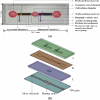Development of an integrated microfluidic perfusion cell culture system for real-time microscopic observation of biological cells
- PMID: 22164082
- PMCID: PMC3231477
- DOI: 10.3390/s110908395
Development of an integrated microfluidic perfusion cell culture system for real-time microscopic observation of biological cells
Abstract
This study reports an integrated microfluidic perfusion cell culture system consisting of a microfluidic cell culture chip, and an indium tin oxide (ITO) glass-based microheater chip for micro-scale perfusion cell culture, and its real-time microscopic observation. The system features in maintaining both uniform, and stable chemical or thermal environments, and providing a backflow-free medium pumping, and a precise thermal control functions. In this work, the performance of the medium pumping scheme, and the ITO glass microheater were experimentally evaluated. Results show that the medium delivery mechanism was able to provide pumping rates ranging from 15.4 to 120.0 μL·min(-1). In addition, numerical simulation and experimental evaluation were conducted to verify that the ITO glass microheater was capable of providing a spatially uniform thermal environment, and precise temperature control with a mild variation of ±0.3 °C. Furthermore, a perfusion cell culture was successfully demonstrated, showing the cultured cells were kept at high cell viability of 95 ± 2%. In the process, the cultured chondrocytes can be clearly visualized microscopically. As a whole, the proposed cell culture system has paved an alternative route to carry out real-time microscopic observation of biological cells in a simple, user-friendly, and low cost manner.
Keywords: ITO glass; cell culture; microfluidics; microheaters; micropumps.
Figures








Similar articles
-
Application of indium tin oxide (ITO)-based microheater chip with uniform thermal distribution for perfusion cell culture outside a cell incubator.Biomed Microdevices. 2010 Jun;12(3):389-98. doi: 10.1007/s10544-010-9395-4. Biomed Microdevices. 2010. PMID: 20107907
-
Microfluidic cell culture chip with multiplexed medium delivery and efficient cell/scaffold loading mechanisms for high-throughput perfusion 3-dimensional cell culture-based assays.Biomed Microdevices. 2011 Jun;13(3):415-30. doi: 10.1007/s10544-011-9510-1. Biomed Microdevices. 2011. PMID: 21234690
-
An integrated microfluidic cell culture system for high-throughput perfusion three-dimensional cell culture-based assays: effect of cell culture model on the results of chemosensitivity assays.Lab Chip. 2013 Mar 21;13(6):1133-43. doi: 10.1039/c2lc41264k. Lab Chip. 2013. PMID: 23353927
-
Pressure-driven microfluidic perfusion culture device for integrated dose-response assays.J Lab Autom. 2013 Dec;18(6):437-45. doi: 10.1177/2211068213503155. Epub 2013 Sep 6. J Lab Autom. 2013. PMID: 24014544 Review.
-
Advances in Microfluidics-Based Technologies for Single Cell Culture.Adv Biosyst. 2019 Nov;3(11):e1900003. doi: 10.1002/adbi.201900003. Epub 2019 Apr 14. Adv Biosyst. 2019. PMID: 32648694 Review.
Cited by
-
Characterization of microparticle separation utilizing electrokinesis within an electrodeless dielectrophoresis chip.Sensors (Basel). 2013 Feb 27;13(3):2763-76. doi: 10.3390/s130302763. Sensors (Basel). 2013. PMID: 23447009 Free PMC article.
-
A microscopy-compatible temperature regulation system for single-cell phenotype analysis - demonstrated by thermoresponse mapping of microalgae.Lab Chip. 2021 May 4;21(9):1694-1705. doi: 10.1039/d0lc01288b. Lab Chip. 2021. PMID: 33949404 Free PMC article.
-
Magnetic Beads inside Droplets for Agitation and Splitting Manipulation by Utilizing a Magnetically Actuated Platform.Micromachines (Basel). 2023 Jun 30;14(7):1349. doi: 10.3390/mi14071349. Micromachines (Basel). 2023. PMID: 37512660 Free PMC article.
-
Microfluidic Platform for the Long-Term On-Chip Cultivation of Mammalian Cells for Lab-On-A-Chip Applications.Sensors (Basel). 2017 Jul 10;17(7):1603. doi: 10.3390/s17071603. Sensors (Basel). 2017. PMID: 28698531 Free PMC article.
-
Optimization of Micropump Performance Utilizing a Single Membrane with an Active Check Valve.Micromachines (Basel). 2017 Dec 21;9(1):1. doi: 10.3390/mi9010001. Micromachines (Basel). 2017. PMID: 30393278 Free PMC article.
References
-
- Xu X, Urban JPG, Browning JA, Tirlapur U, Wilkins RJ, Wu MH, Cui Z, Cui ZF. Influences of buffer systems on chondrocyte growth during long-term culture in alginate. Osteoarthritis Cartilage. 2007;15:396–402. - PubMed
-
- Wu MH, Urban JPG, Cui ZF, Cui Z, Xu X. Effect of extracellular pH on matrix synthesis by chondrocytes in 3D agarose gel. Biotechnol. Prog. 2007;23:430–434. - PubMed
-
- Wu MH, Huang SB, Cui ZF, Cui Z, Lee GB. Development of perfusion-based micro 3-D cell culture platform and its application for high throughput drug testing. Sens. Actuat. B. 2008;129:231–240.
-
- Cui ZF, Xu X, Trainor N, Triffitt JT, Urban JP, Tirlapur UK. Application of multiple parallel perfused microbioreactors and three-dimensional stem cell culture for toxicity testing. Toxicol. In Vitro. 2007;21:1318–1324. - PubMed
-
- Wu MH, Kuo CY. Application of high throughput perfusion micro 3-D cell culture platform for the precise study of cellular responses to extracellular conditions-effect of serum concentrations on the physiology of articular chondrocytes. Biomed. Microdevices. 2011;13:131–141. - PubMed
Publication types
MeSH terms
LinkOut - more resources
Full Text Sources
Other Literature Sources
Research Materials
Miscellaneous

